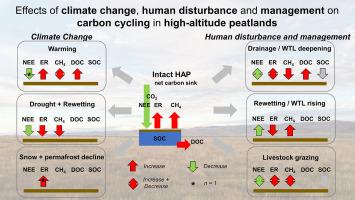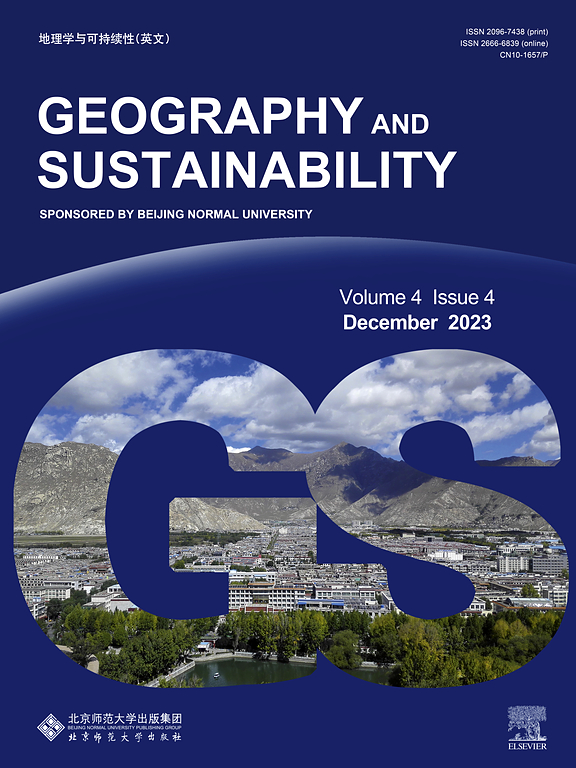The high-altitude peatland carbon cycle: A review of the impacts of climate change, human disturbance and management
IF 8
1区 环境科学与生态学
Q1 GEOGRAPHY, PHYSICAL
引用次数: 0
Abstract
High-altitude peatlands (HAPs; defined as > 1,500 m) provide important ecosystem services including soil carbon (C) storage. However, temperatures in high-altitude regions have been rising rapidly in recent decades, while HAPs are increasingly affected by human activities such as intensive drainage and grazing. Collectively, climate change and land management may strongly affect the HAP C cycle. Here, we synthesise current global progress on the HAP C cycle, focussing on the impacts of climate change and land management. Warming increased both ecosystem respiration (ER) and methane (CH4) emissions (26 %–86 %), while impacts on net ecosystem exchange (NEE) of CO2 were still unclear. However, short-term drought decreased ER and CH4 emissions (7 %–96 %), along with NEE (12 %–52 %). Snow, permafrost, and glacier decline may also impact the C cycle in HAPs, although a limited number of studies have been conducted. Grazing and vegetation degradation impacts on HAP C cycling were related to grazing and degradation intensity, while generally decreasing soil organic C stocks (3 %–51 %). Moving from shallower to deeper WTLs stimulated ER (9 %–812 %), while reducing CH4 emissions (13 %–100 %), with variable effects on NEE (-53 %–700 %). Restoration by rewetting began to reverse the trend of drainage. We highlight several knowledge gaps, including limited understanding of climate change and land-management effects on gross primary productivity and dissolved organic carbon, while there is still limited knowledge of regional differences in HAP C cycling. Future research should focus on the interaction of land-use and climate change in HAPs, including HAP restoration, which may help future conservation of these valuable ecosystems.

气候变化、人为干扰及管理对高原泥炭地碳循环的影响
高海拔泥炭地(HAPs;定义为1500米)提供重要的生态系统服务,包括土壤碳(C)储存。然而,近几十年来,高海拔地区的气温一直在迅速上升,而HAPs越来越多地受到人类活动(如集约排水和放牧)的影响。总的来说,气候变化和土地管理可能强烈影响HAP - C循环。在这里,我们综合了目前全球在HAP - C循环方面的进展,重点关注气候变化和土地管理的影响。变暖增加了生态系统呼吸(ER)和甲烷(CH4)排放(26% ~ 86%),而对二氧化碳净生态系统交换(NEE)的影响尚不清楚。然而,短期干旱减少了ER和CH4的排放(7% - 96%),以及NEE(12% - 52%)。尽管开展的研究数量有限,但积雪、永久冻土和冰川的减少也可能影响HAPs中的C循环。放牧和植被退化对有机碳循环的影响与放牧和退化强度有关,而土壤有机碳储量普遍减少(3% ~ 51%)。从较浅的水体向较深的水体移动可刺激ER(9% - 812%),同时减少CH4排放(13% - 100%),对NEE有不同的影响(- 53% - 700%)。复湿恢复开始逆转排水趋势。我们强调了一些知识空白,包括对气候变化和土地管理对总初级生产力和溶解有机碳的影响的了解有限,而对HAP - C循环的区域差异的了解仍然有限。未来的研究重点应放在旱地生态系统土地利用与气候变化的相互作用上,包括旱地生态系统的恢复,这可能有助于这些宝贵生态系统的未来保护。
本文章由计算机程序翻译,如有差异,请以英文原文为准。
求助全文
约1分钟内获得全文
求助全文
来源期刊

Geography and Sustainability
Social Sciences-Geography, Planning and Development
CiteScore
16.70
自引率
3.10%
发文量
32
审稿时长
41 days
期刊介绍:
Geography and Sustainability serves as a central hub for interdisciplinary research and education aimed at promoting sustainable development from an integrated geography perspective. By bridging natural and human sciences, the journal fosters broader analysis and innovative thinking on global and regional sustainability issues.
Geography and Sustainability welcomes original, high-quality research articles, review articles, short communications, technical comments, perspective articles and editorials on the following themes:
Geographical Processes: Interactions with and between water, soil, atmosphere and the biosphere and their spatio-temporal variations;
Human-Environmental Systems: Interactions between humans and the environment, resilience of socio-ecological systems and vulnerability;
Ecosystem Services and Human Wellbeing: Ecosystem structure, processes, services and their linkages with human wellbeing;
Sustainable Development: Theory, practice and critical challenges in sustainable development.
 求助内容:
求助内容: 应助结果提醒方式:
应助结果提醒方式:


